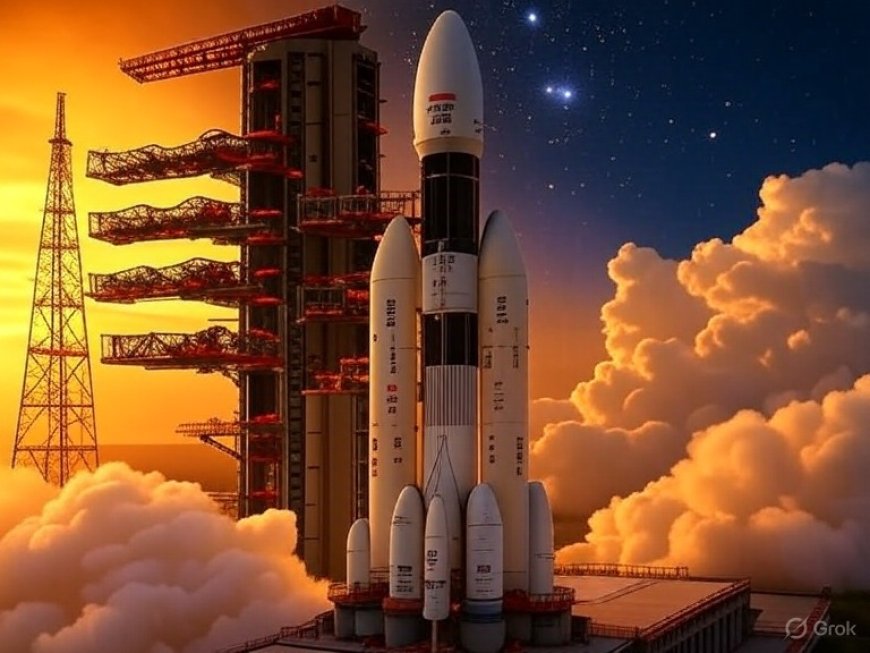Historic Milestone: ISRO and NASA to Launch Joint Earth Observation Satellite NISAR on July 30
On July 30, 2025, ISRO's GSLV-F16 will launch NISAR, the first joint Earth observation satellite by ISRO and NASA, from Sriharikota. Here's everything you need to know about this historic collaboration.

A New Era in Space Cooperation: ISRO and NASA Set to Launch NISAR on July 30, 2025
In a momentous stride for global space research, ISRO (Indian Space Research Organisation) and NASA (National Aeronautics and Space Administration) are set to jointly launch their pioneering Earth observation satellite—NISAR (NASA-ISRO Synthetic Aperture Radar)—on July 30, 2025, at 17:40 IST, from the Satish Dhawan Space Centre in Sriharikota, India.
This launch, using ISRO’s GSLV-F16 (Geosynchronous Satellite Launch Vehicle), marks a historic first-of-its-kind collaboration between the two premier space agencies. Designed to revolutionize the way we observe and understand Earth’s dynamic processes, NISAR is expected to provide unparalleled data on climate change, natural disasters, and environmental changes.
What is NISAR?
NISAR, short for NASA-ISRO Synthetic Aperture Radar, is an advanced Earth observation satellite equipped with dual-frequency radar technology (L-band and S-band). It is the first satellite of its kind that can systematically scan and monitor the entire globe every 12 days with ultra-high resolution.
The satellite will play a pivotal role in tracking:
-
Deforestation and forest degradation
-
Land subsidence and soil moisture levels
-
Glacier movements and polar ice melt
-
Earthquake and landslide-prone zones
-
Agricultural monitoring and resource mapping
This cutting-edge radar satellite is a culmination of over a decade of collaborative work between NASA’s Jet Propulsion Laboratory (JPL) and ISRO’s U R Rao Satellite Centre (URSC).
Mission Significance: Why NISAR Matters
The significance of the NISAR mission cannot be overstated. With the climate crisis escalating globally, NISAR is uniquely equipped to provide critical geophysical data to scientists, disaster response teams, environmental policy makers, and government agencies across the globe.
According to NASA’s Earth Science Division, the satellite will help improve predictive models and decision-making tools for climate resilience, enabling better responses to extreme weather events and natural disasters.
For ISRO, the mission is equally important, not only for its technological complexity but also for its strategic collaboration with NASA, which solidifies India’s place among the top players in global space exploration.
The GSLV-F16 Launch Vehicle: Engineered for Power
The GSLV-F16 is the latest version of ISRO’s heavy-lift launch vehicle, capable of carrying heavier payloads to higher orbits. For the NISAR mission, GSLV-F16 has been optimized to:
-
Deploy the satellite into a Sun-synchronous orbit (SSO) at an altitude of approximately 747 km
-
Support the unique weight distribution and structure of the dual-band radar instrument
-
Ensure maximum reliability and precision during satellite separation and orbital insertion
This will be GSLV’s 16th mission, and ISRO engineers have incorporated significant upgrades to its cryogenic upper stage and avionics systems.
Key Mission Details
| Parameter | Details |
|---|---|
| Satellite Name | NISAR |
| Launch Vehicle | GSLV-F16 |
| Launch Date | July 30, 2025 |
| Time | 17:40 IST |
| Launch Site | Satish Dhawan Space Centre, Sriharikota |
| Orbit Type | Sun-Synchronous Orbit (SSO) |
| Mission Duration | Minimum 3 years |
| Partners | ISRO & NASA |
A Decade of Collaboration
The partnership that birthed NISAR began formally in 2014, when ISRO and NASA signed a memorandum of understanding to co-develop this satellite. The division of responsibilities was clear:
-
NASA provided the L-band SAR (Synthetic Aperture Radar), GPS receivers, high-capacity data recorders, and mission system software
-
ISRO developed the S-band SAR, satellite bus, GSLV-F16 launch vehicle, and other ground support systems
The total cost of the mission is estimated at ₹9,000 crore, with contributions shared between the two agencies. The data generated by NISAR will be freely available to researchers, in line with both agencies' open-data policies.
What Happens After Launch?
Once in orbit, NISAR will undergo a series of in-orbit tests before being fully operational by early 2026. The satellite is expected to transmit 12 TB of data per day, providing valuable datasets to the global scientific community.
Data will be received by ISRO’s Indian National Remote Sensing Centre (INRC) and NASA’s Alaska Satellite Facility (ASF). Both agencies will maintain mirrored repositories to support global access.
Broader Implications for India and the World
India has long sought to build capacity in climate and environmental monitoring, and NISAR represents a quantum leap forward. With precise and frequent readings of land surface changes, Indian policymakers will be better equipped to:
-
Monitor and mitigate the effects of urbanization and land degradation
-
Develop climate-adaptive agriculture strategies
-
Track water usage and groundwater depletion
-
Enhance early warning systems for floods, droughts, and earthquakes
Globally, NISAR will assist the United Nations Sustainable Development Goals (SDGs) and strengthen international collaborations on climate action and disaster risk reduction.
Conclusion: A Launch That Will Reshape Earth Observation
As the countdown begins for July 30, 2025, the world awaits with anticipation. The launch of NISAR via GSLV-F16 not only symbolizes the technical prowess of ISRO and NASA but also the power of international cooperation in tackling some of the planet's most pressing issues.
This mission represents a blueprint for future collaborations in space exploration, where data sharing and joint missions can lead to greater scientific understanding and humanitarian benefit.
For ongoing updates on the NISAR mission, visit the ISRO official website or NASA’s NISAR mission page.



















































